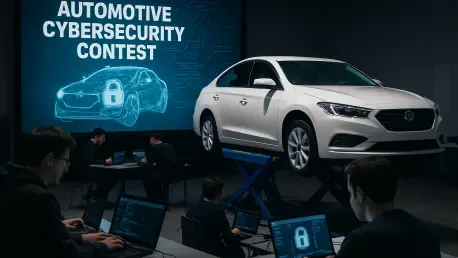Setting the Stage for Cybersecurity in Connected Vehicles
In an era where vehicles are as much about software as they are about steel, the automotive industry faces a mounting challenge: securing the digital backbone of modern cars against cyber threats. With millions of connected vehicles on the road, a single cyber vulnerability could compromise safety, disrupt infrastructure, or erode consumer trust, making cybersecurity a top priority. This pressing reality sets the stage for a pivotal event organized by Trend Micro’s Zero Day Initiative (ZDI), scheduled for January during the Automotive World event in Tokyo. This hacking contest, with a prize pool exceeding $3 million, draws global security researchers to expose flaws in automotive systems, highlighting the critical need for robust defenses.
The significance of this competition extends beyond mere spectacle. As cars integrate advanced technologies like autonomous driving and connected charging networks, the potential attack surface for hackers grows exponentially. This event serves as a crucible for testing the resilience of these systems, offering a glimpse into the vulnerabilities that could shape the future of mobility if left unaddressed. It’s a timely initiative, reflecting the industry’s urgent push to stay ahead of cyber threats in an increasingly digitized landscape.
Unpacking the Contest’s Core Features and Categories
Tesla Vehicle Exploits: High Stakes and High Rewards
One of the most anticipated segments of the competition focuses on Tesla vehicles, a brand synonymous with cutting-edge electric and autonomous technology. Participants can earn up to $500,000 for exploits, with the added allure of winning a Tesla vehicle for feats like remotely hacking the autopilot system with unconfined root access. The challenges target critical components such as electronic control units (ECUs) and CAN bus communication, with bonuses for persistent root access on infotainment and autopilot systems, underscoring the real-world implications of such vulnerabilities.
Safety remains a priority during these high-stakes tests. Organizers may employ RF enclosures to prevent interference with nearby vehicles, ensuring that experiments don’t inadvertently affect operational systems. This category not only tests the limits of Tesla’s security architecture but also sets a benchmark for how manufacturers must fortify their defenses against sophisticated cyber-attacks, given the brand’s prominence in the market.
In-Vehicle Infotainment Systems: A Gateway to Control
Another critical area under scrutiny is in-vehicle infotainment (IVI) systems, which serve as a nexus for connectivity within modern cars. Successful exploits in this category can net researchers up to $20,000, reflecting the importance of securing these interfaces that often link to deeper vehicle networks. A breach here could provide hackers with a foothold to manipulate other systems, making IVI a prime target for testing.
The focus on IVI systems reveals how seemingly peripheral components can pose significant risks. As these platforms become more integrated with navigation, communication, and entertainment features, their security must be airtight to prevent cascading failures across a vehicle’s architecture. This segment of the contest highlights a less glamorous but equally vital aspect of automotive cybersecurity.
Electric Vehicle Charger Security: Protecting the Power Grid
The competition also turns its attention to electric vehicle (EV) charging infrastructure, a cornerstone of the growing EV ecosystem. Targeting both Level 2 and Level 3 chargers, with prizes up to $40,000 and $60,000 respectively, challenges include systems like the Aplitronic supercharger. Securing these points is paramount, as vulnerabilities could disrupt charging networks or even impact broader power grids.
This category emphasizes the interconnected nature of modern mobility solutions. With EV adoption accelerating, chargers represent not just a convenience but a potential weak link in the chain of automotive security. Testing these systems under contest conditions offers valuable insights into how manufacturers and infrastructure providers can safeguard against threats that extend beyond the vehicle itself.
Open Charge Point Protocol: Securing Communication Standards
A newer addition to the lineup is the Open Charge Alliance category, focusing on the Open Charge Point Protocol (OCPP), which governs communication between charging stations and central management systems. With a prize of $15,000 for successful exploits, this segment addresses the often-overlooked realm of standardized protocols that underpin EV infrastructure.
The importance of securing OCPP cannot be overstated as charging networks expand globally. A flaw in this communication layer could enable attackers to manipulate charging operations or harvest sensitive data, posing risks to both users and providers. This category reflects the contest’s commitment to tackling emerging challenges in the rapidly evolving EV landscape.
Automotive Operating Systems: The Foundation of Vehicle Safety
Rounding out the categories are automotive operating systems, including platforms like Automotive Grade Linux, BlackBerry QNX, and Android Automotive OS, with rewards reaching up to $60,000. These systems form the bedrock of vehicle functionality, controlling everything from safety features to user interfaces. A breach at this level could have catastrophic consequences, making their security a top priority.
Testing these foundational platforms in a competitive environment sheds light on systemic risks that might otherwise go undetected. As vehicles become more software-defined, ensuring the integrity of operating systems is essential to maintaining trust and safety. This segment of the contest underscores the need for robust, resilient software in an industry undergoing rapid transformation.
Performance and Impact on Industry Trends
The structure of this hacking contest mirrors broader trends in automotive cybersecurity, where the integration of autonomous features, connected infrastructure, and complex software has heightened the stakes. With vehicles becoming rolling data centers, the attack surface for cyber threats has expanded, necessitating proactive measures to identify and mitigate risks. This event exemplifies the industry’s shift toward public vulnerability disclosure and competitive testing as tools to strengthen security protocols.
Beyond immediate results, the competition’s focus on diverse targets—from high-profile Tesla systems to ubiquitous EV chargers—demonstrates a comprehensive approach to addressing vulnerabilities. It serves as a catalyst for manufacturers to prioritize cybersecurity in design and development phases, pushing the envelope on what secure automotive technology should look like. The substantial prize pool and unique incentives ensure participation from top-tier researchers, amplifying the potential for groundbreaking discoveries.
Moreover, the findings from this event are poised to influence regulatory frameworks and industry standards over the coming years, from now through 2027 and beyond. As cyber threats evolve, contests like this provide a testing ground for innovations that could shape safer, more resilient vehicles. The emphasis on real-world applicability ensures that exploits uncovered during the event translate into actionable improvements for manufacturers and consumers alike.
Reflecting on Outcomes and Charting the Path Forward
Looking back, the event organized by Trend Micro’s Zero Day Initiative in Tokyo proved to be a landmark moment in exposing critical vulnerabilities across automotive systems. The diverse categories, backed by a prize pool of over $3 million, incentivized researchers to push boundaries, uncovering flaws that could have had severe implications if exploited maliciously. It was a testament to the power of competitive hacking in driving security advancements.
Moving forward, the industry must leverage these insights to implement stronger safeguards, particularly in high-risk areas like autopilot systems and charging infrastructure. Collaborative efforts between manufacturers, regulators, and security experts will be crucial to develop standards that keep pace with technological innovation. Investing in continuous testing and fostering responsible disclosure practices should remain a priority to preempt future threats.
Additionally, building consumer confidence in connected vehicles hinges on transparent communication about security measures and swift remediation of identified flaws. Events like this one lay the groundwork for such trust, but sustained commitment to cybersecurity will be essential. As the automotive landscape evolves, integrating lessons from this contest into long-term strategies offers a roadmap for safer, more secure mobility solutions.









